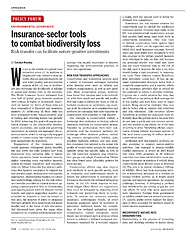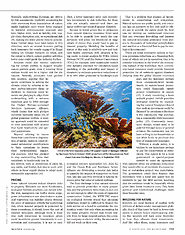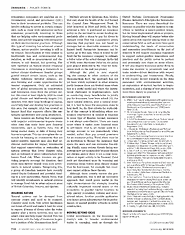Food for thought. From SCIENCE Magazine, published by the American Association for the Advancement of Science:
Insurance-sector tools to combat biodiversity lossIN SECTION POLICY FORUM | ENVIRONMENTAL ECONOMICS
We are in the middle of a global mass extinction event (1). In addition to heightened risks related to food security, disease, natural disasters, air and water quality, and nonmaterial aspects of life (1), loss of biodiversity also threatens the livelihoods of billions of people and creates risks to the economy. The World Economic Forum estimated that over half of global gross domestic product ($44 trillion) is highly or moderately dependent on nature (2). Some of these risks are then transmitted to financial and insurance markets (3). Addressing all these risks has been articulated in the “nature-positive” goal of halting and reversing nature loss globally by 2030. Achieving this goal will require profound changes in the relationship between nature, economies, and social and governing institutions. As leading risk managers, the insurance sector, which is not typically engaged widely on nature issues, has multiple tools to help mainstream the transition.
Engagement of the insurance sector would generate widespread global benefits, but also lower the risks insurers face from biodiversity loss, including risks of higher claims payments, lower investment returns, higher operating costs, reputation impacts, and/or increased regulatory and transition risks (4). Below, I describe five primary pathways that insurers can pursue to support nature-positive goals: creating new risk-transfer approaches, incorporating impacts on nature into underwriting, pricing for the risk reduction benefits provided by natural systems, applying a nature-positive lens to investments, and insuring nature itself (5). Despite myriad reports and papers suggesting possible approaches for insurers to have an impact in this area, the number of pilots or programs that have actually been implemented is much smaller and is the focus of this discussion. Not discussed here, given the many other treatments of corporate environmental stewardship— but equally important—is insurers improving the environmental practices of their own operations.
NEW RISK-TRANSFER APPROACHES
Conservation and restoration projects need a variety of insurance coverages, including some familiar ones, such as liability and worker’s compensation, as well as new products. Many conservation groups, however, have found that insurers tend to be unfamiliar with their needs and specific risk profile. This has made it difficult for them to find affordable insurance or, sometimes, any coverage at all. In response, new organizations and products are emerging that unite expertise in conservation with expertise in risk transfer.
One example is Conservation United, a brokerage firm dedicated to finding tailored insurance solutions for conservation groups. Founded by professionals from both conservation and the insurance industry, the brokerage offers standard policies, including workers compensation, liability, auto, accident, umbrella policies, and also pollution insurance, but tailored to the actual risk profile of conservation groups. By educating insurers about the specific risks, as well as the risk reduction measures that conservation groups can adopt, Conservation United has often found more affordable policies for these groups.
Conservation efforts may also require new products to meet specific needs, such as insurance and performance bonds to assure the achievement of ecological performance standards for wetland mitigation banks. In the US, when impacts to wetlands trigger Clean Water Act regulations, they must be mitigated by restoring other wetlands and preserving them in perpetuity. To receive the necessary permits, insurance, performance bonds, or other financial assurance must be provided to guarantee sufficient funds for completion of the wetland mitigation activity. Conservation United cofounder, Chris Baker, has developed such a product where failure to achieve a defined ecological performance standard for a wetland triggers a claim, with the payout used to bring the wetland into compliance.
Sometimes, the risk transfer solution for conservation may lie outside the traditional insurance market. Consider land trusts in the US, non-governmental conservation groups that protect land using legal tools such as conservation easements. They may have to defend conservation lands against legal challenges, which can be expensive and for which they need insurance coverage. Several years ago, land trusts were struggling to find this coverage in the private market. Insurers were reluctant to take on this risk because the potential market was small and there was not much historical data on the size of the risk (and if insurers did take it on, they would charge a high premium). In response, the Land Trust Alliance created Terrafirma Risk Retention Group LLC. It has an unusual organizational structure, being both a nonprofit organization and a captive, which is an insurance provider that is owned by the members to whom it provides coverage. Captives are a useful solution for risks that are difficult or too pricey to find coverage for in the market and have been used by many sectors. Being owned by members, they may also be better able to support risk reduction and risk education. This structure allows Terrafirma to provide the insurance more efficiently than the private sector, because they do not take a profit and can reinvest premiums not needed to pay claims. As of the time of writing in 2022, Terrafirma offered conservation defense liability insurance policies to 545 land trusts covering 10 million acres of conservation land.
Additional new risk-transfer products are also emerging to support nature-positive activities. One example is human–wildlife conflict insurance. A review in 2017 found that since 1980, programs in 50 different countries have been established to make payments to farmers or ranchers if wildlife from conservation areas destroy crops or livestock (6). The aim is to reduce retaliatory killings of wildlife. There has been increasing interest in harnessing insurance as a solution to human–wildlife conflict as it might speed payouts and improve operations. An ongoing challenge, however, is designing a product that beneficiaries are willing to pay for and can afford. To solve this, some approaches have channeled funding from government or wildlife-related tourism toward premiums (7). Indeed, public-sector support for insurance is often necessary for products aimed at lower-income populations.
INCORPORATE NATURE INTO UNDERWRITING
Underwriting is the process of evaluating risks and deciding whether to insure them.
Typically, underwriting decisions are driven by risk assessments. Explicitly accounting for risks stemming from degradation of nature might highlight cases where firms engaged in harmful environmental practices also have higher risks, such as liability risk, supply chain disruption risk, or reputational risk (8), making the firms poorer risks to assume. Some limited steps have been taken in this direction, such as several insurers pulling back insurance for vessels engaged in illegal fishing (9). Greater research on when, and the extent to which, nature-positive activities lower risks could guide the industry further.
Insurers could also restrict underwriting for certain entities to support broader nature-positive goals, even if insuring those entities would not be a higher risk for the insurer. Recently, advocates have pushed this position, arguing that insurers contribute to solving the climate crisis by refusing to insure carbon-intensive firms or facilities. In response, some insurers are pledging to align their underwriting with a net-zero emissions goal by 2050 through the United Nations–convened Net-Zero Insurance Alliance, which claims that such pledges currently represent about 11% of global premium written. A similar approach could be extended to risks associated with actions that harm biodiversity and species’ populations.
Beyond refusing to insure firms that contribute to degradation of nature, insurers could demand substantial modifications to their operations to lessen their environmental impact. For example, AXA has pledged to stop underwriting firms that contribute to biodiversity loss in key sectors, such as production of palm oil, soy, cattle, and timber, but also to work with others in these supply chains to adopt more sustainable approaches (10).
PRICING
Some natural systems reduce disaster risks to property. Wetlands can store floodwaters, ecological forestry practices can reduce wildfire risk, mangroves can buffer storm surge, green infrastructure can absorb storm water, and vegetation can stabilize slopes. Because the price of insurance reflects the underlying risk, when insured property is protected by these ecosystems, it should lower the cost of disaster insurance. Although there is hope that such reductions in insurance prices could incentivize greater investments in conservation and restoration, it is not so easy.
First, a lower insurance price only incentivizes investments in risk reduction for those who are actually insured—and there are many entities not insured against disasters.
Second, to lower prices due to protection from natural systems, insurance firms need to be able to quantify how much the conservation will affect the likelihood or magnitude of claims they would have to pay on insured property. Modeling the benefits of nature at this scale is relatively new and typically highly uncertain. Still, progress is being made. A recent analysis by Willis Towers Watson (WTW) and The Nature Conservancy (TNC), for example, used catastrophe models (the industry standard for simulation-based modeling of the probability and impact of disasters) to estimate premium reductions of 10 to 40% when protected by landscape-scale ecological forestry approaches (11). AXA XL and the Ocean Risk and Resilience Action Alliance are developing a coastal risk index to quantify the impact of mangroves on flood risk; one use case they envision is helping insurers price the value of natural systems.

The final challenge is that natural systems tend to provide protection to many properties, and the premium reductions on just one are not enough to offset the costs of expanded conservation. Indeed, the WTW-TNC report on ecological forestry found that premium reductions would be sufficient to finance the debt service on a bond to undertake the restoration work—but only when accounting for the many property owners that would benefit. Even for large insured parties, like a timber company or electric utility, the economics did not work on their own.
That is a problem that plagues all investments in conservation and restoration. Natural systems are public goods, and everyone has an incentive to free ride and let others pay to provide the public good. So, how can we develop an institutional structure that can overcome free-riding and harness the reduced insurance premiums from dozens to thousands of individual policyholders and use that as a financial flow to pay for ecological investments?
There are some innovative options to harness premium reductions as a financing flow, none of which are yet in operation. One is to consider insurance at the level of the community instead of the individual. Such community-based insurance could provide financial protection for all residents against disasters (helping close the global disaster insurance gap), and the insurance savings from community-level investments in nature-based protection could financially justify greater investments in nature (12). A study examining a levee setback project (which provides ecological benefits by expanding the natural floodplain) found that such an investment could be financed by premium reductions if the community was purchasing a community-wide insurance policy (13). Community insurance, though, would need to be paid for through taxes or general revenue. No community has yet been willing to tax households or use other funds to purchase this type of community insurance.
Without a single policy, it is trickier to use insurance savings to pay for conservation or restoration. One option is for a local government or special-purpose district to enter an agreement with insurers about the premium reductions they would offer to all residents if a conservation or restoration project was undertaken. The government could then finance that investment with a bond and assess fees on residents to pay the debt service, knowing that the residents would be financially whole given their lower insurance costs. This faces political and institutional challenges more than financial ones.
INVESTING FOR NATURE
Insurers are large holders of capital, with trillions of dollars under management globally. Much of this must be held in lower-risk assets to ensure future claims-paying ability. But insurers still have some flexibility in how they allocate their investments. And like other firms, many insurance and reinsurance companies are applying an environmental, social, and governance (ESG) lens to their investment portfolio. This can involve refusing to invest in certain companies, such as those with substantial carbon emissions; proactively investing in firms that are helping solve environmental problems; and actively engaging with companies on their environmental practices. Although this type of investing has advanced around climate, nature-positive investing is still in its infancy. Identification of risks related to biodiversity loss and environmental degradation, as well as measurement and disclosure, is still limited, but growing. The new Taskforce on Nature-related Financial Disclosures is developing a framework to mirror climate disclosures. Smaller groups guided toward certain issues, such as the Plastic Solutions Investor Alliance, are also forming and create opportunities for insurer engagement. Only an estimated 14% of global investments in conservation and restoration come from the private sector; this must at least triple by 2030 to meet global climate and biodiversity targets (14). Insurers, with their large holdings of capital, could help lead and develop best practices in this area. For example, AXA has created an impact fund that supports efforts like sustainable agroforestry and cocoa production.
Some insurers are finding that companies with negative environmental impacts create other risks that make them poor financial investments, such as liability risks, risk of losing market share, or risks of losing their license to operate. This can strengthen the rationale for focusing on investments that are nature-positive. Insurers may also find additional motivation for impact investments that support conservation or restoration of natural systems that lower disaster risks, such as wetlands or green infrastructure that lowers flood risk. When insurers are providing property coverage for disasters, they could then directly benefit from such investments in natural systems. Recognizing this, a group of Canadian insurers have recently joined Ducks Unlimited and provided funding to a new partnership, Nature Force, that will identify investments in natural systems to manage flood risk in urban-adjacent areas of British Columbia, Ontario, and Quebec.
INSURING NATURE
Natural systems can be damaged from extreme events and need to be repaired. Consider coral reefs. Very severe hurricanes can break off coral and make it hard for coral to regrow. If teams of divers enter the water quickly after a storm, however, they can reattach coral and help repair the reef. This has been done, with the help of insurance, to protect a portion of the Mesoamerican Reef.
Multiple groups in Quintana Roo, Mexico, that care about the health of the reef formed the Coastal Zone Management Trust. In 2019 (renewed in 2020 and 2021), the Trust achieved a first: It purchased an insurance policy on the reef itself to secure funding immediately after a storm to pay for divers to reattach coral. This was a parametric policy, meaning that payment was not based on damages but on observable measures of the hazard itself. Parametric insurance can be useful, as in this case, when it would be difficult for the insurance company to estimate a dollar value of the actual damage. In the fall of 2020, when Hurricane Delta hit, the policy paid around $800,000 to the Trust for restoration work on the reef (see photo).
Although the pilot is now expanding the concept to other sections of the Mesoamerican Reef, the approach has not yet been widely replicated in other systems, partly because there are limited cases where this is a useful model and where the institutional challenges in implementation, such as convincing many beneficiaries to jointly pay for insurance, have been solved (15). For many natural systems, after a natural disaster, it is best to leave the ecosystem alone to heal itself. So, the first criteria for replicability of this concept is identifying where restoration intervention is needed in response to some type of disaster. Second, insurance is not always cost-effective. There are many times where it makes more financial sense to self-insure—that is, set money aside in a savings account to use immediately when needed, rather than pay annual premiums for an insurance policy. Third, there must be an institution to finance the insurance that spans the users and can overcome free-riding. Finally, many serious threats facing ecosystems now are uninsurable because threats are chronic and/or there is not a clear restoration or repair activity to be financed. Coral reefs are threatened more by warming and acidifying ocean waters from climate change than by hurricanes, for example, but insurance cannot address those threats.
Although those criteria narrow the possible applications, this is still an innovative approach that could prove useful in the right circumstances—for example, insuring culturally important natural assets or the ecosystems in popular tourist locations to help quickly reestablish cultural and recreational values. Another possible application is to insure green infrastructure for its performance, or against possible setbacks in initial construction.
MOVING BEYOND IDEAS
Global coordination on the insurance industry’s role in broader environmental topics is emerging, such as through the United Nations Environment Programme Finance Initiative’s Principles for Sustainable Insurance. There are many theoretical discussions on possible roles for insurers to contribute to building a nature-positive future, but far fewer implemented pilots or projects. Moving beyond ideas will require better education about risk transfer among those in the conservation field, as well as more time spent understanding the needs of conservation and restoration practitioners on the part of insurers. It will require insurance regulators to support nature-positive innovations and practices and the public sector to partner and potentially cost share on some efforts. It will also require insurance-sector firms to make the decision to proactively lead and make mission-driven decisions with respect to underwriting and investments. Finally, it will require deeper research on the risks associated with environmental activities, an exploration of current barriers to implementation, and a sharing of best practices to move from theory to practice.
Environmental Defense Fund, Philadelphia, PA, USA. Email: ckousky@edf.org
REFERENCES AND NOTES
ACKNOWLEDGMENTS
I thank the National Science Foundation (award 1939913) for support of this work.
10.1126/science.abo7282



No comments:
Post a Comment